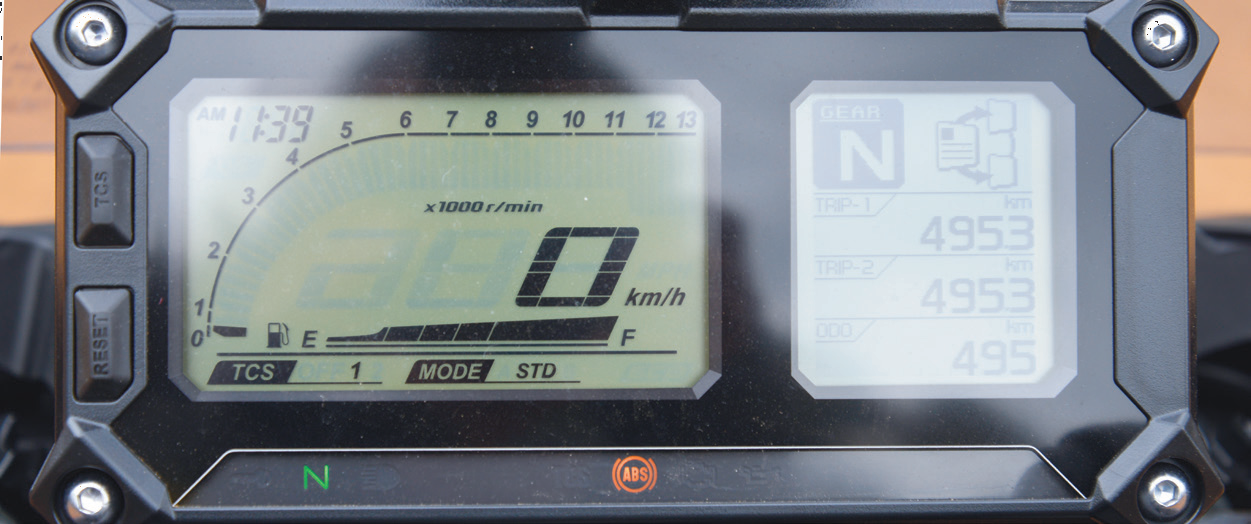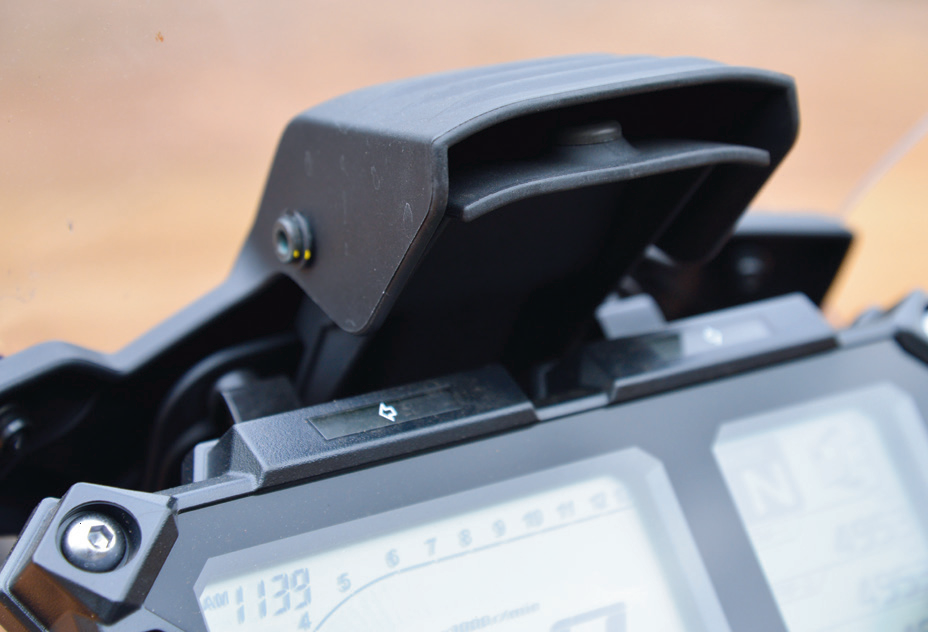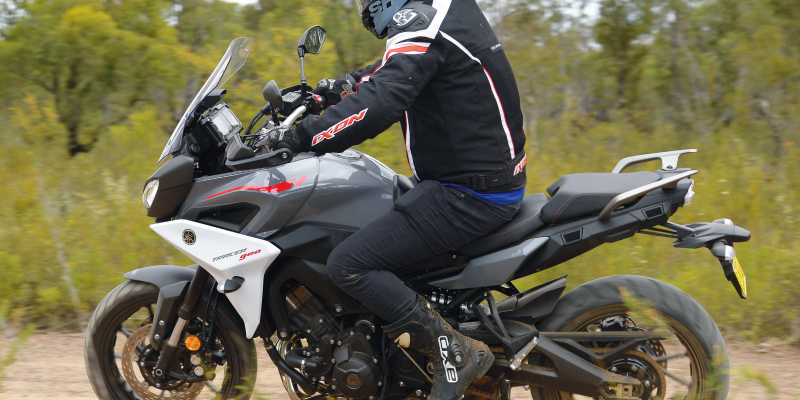- It’s what we do – adventure motorbike magazine
- BMW GS Safari Enduro = adventure motorbikes, news, reviews, publication
- BMW F850GS Rallye X
- Strap Yourself In
- The Dempster
- TomTom Rider 450
- Read Between The Lines
- Locked Gates – motorbike magazine, australian motorcycle publication
- Ural Adventure Ride 2018
- Sri Lanka – adventure motorbike tour, motorcycle magazine
- The Best Job In The World = australian motorbike magazine
- Wet Arses
- Yamaha Tracer 900
- Congregation 2018
- We Didn’t Have PLBs In Those Days
- Sahara To Sunraysia = australian motorbike riding tours news event magazine
- Managing Risk with Miles Davis
- Thinking Big? Start Small with Andy Strapz
- A Precautionary Tale from Karen Ramsay
- Checkout
- Fit out – australian adventure motorbike riding
Yamaha markets the Tracer as a sports tourer, and it’s definitely happiest on the road. There’s a dualsporter lurking around under that aerody-namic panelwork, though. With a motor as good as this one, we doubt there’s much this bike couldn’t do.
 The Tracer’s happy enough on dirt roads. With more aggressive tyres we reckon
The Tracer’s happy enough on dirt roads. With more aggressive tyres we reckon
it’d be a capable dualsporter.
Yamaha has two models of the Tracer in 2018. The Tracer GT has panniers, a TFT dash, adjustable forks and a few other tasty features and has had a lot of media attention. The bike we have here is the ‘base’ model. It’s mechanically the same spec as the GT, but doesn’t have some of the up-spec options. There’s compression adjustment only on the front, an LCD dash and no panniers. It still has the three riding modes, slipper clutch, an 18-litre tank and a centrestand, all as standard fittings, so at $15,799 plus on-roads it’s a tidy package at a sharp price.
 The screen and body shape around the front of the bike keep the rider out of the worst of the wind blast.
The screen and body shape around the front of the bike keep the rider out of the worst of the wind blast.
Hidden talent
After a very brief ride on the 2018 Tracer we were left scratching our heads.
The bike is clearly a road bike. On the bitumen heading out to a dirty little location not too far from Yamaha Motor Australia’s headquarters in western Sydney, the Tracer shone. It purred its way through city traffic, whistled along freeways without putting in any effort, and when we felt a little uppity, it revelled in being asked to take low-percentage options exiting turns or choosing tight, fast lines.
We also loved the way the screen could be adjusted by just grabbing a big clip arrangement and sliding it up or down, even while we were riding along.
So that was all clear enough.
But when we did hit the dirt the bike didn’t throw up its hands and surrender. It seemed just as keen to shimmy its way through the dust and whoops as it was to launch from the lights at a main-road intersection.
 Crikey. The pipes look a little funky, but they stay above the bottom of the engine, so aren’t as vulnerable as they appear at first glance.
Crikey. The pipes look a little funky, but they stay above the bottom of the engine, so aren’t as vulnerable as they appear at first glance.
All about the motor
Keen the Tracer may have been in the dirt, but the tyres – Dunlop Sportmax front and rear – which had encouraged lively riding on the road, were a severely limiting factor in the sand, dust and, worst of all, the mud we found during our ride. It was a little frustrating really, because the heart of the Tracer is the three-cylinder, 847cc, DOHC, four-valves-per-cylinder motor, and it’s a sweetheart. Drive is very smooth. In the lower rev range, up to about 4000rpm, it’s fairly restrained, making it perfect for managing the fully fuelled 214kg bike when grip and feedback is low. From about 5000rpm up though, response becomes sharp and the bike slingshots away, leaving a rider to hold on as best he can.
While we’re thinking about it, the clutch on the Tracer is a pearler. It’s very light and progressive, and it’s cable-operated. Nice.With a set of even 50/50 road/dirt tyres the Tracer would be a very capable dirt-road mount. With more aggressive tyres front and rear it could be a real goer.

Mix’n’match
There are three riding modes to choose from: A, Standard, and B.
Mode A gives the sharpest, sportiest throttle response, B is the rain or slippery-surface option and Standard is, well…standard.
Along with the modes is the option to turn off the traction control, and fiddling around with different combinations of those things allowed a considerable shaping of the bike’s character. That purring powerplant could be a wildcat or a pussy cat, depending on which combination of settings was in use.
There’s ABS front and rear of course, and it seemed to us it worked well. We didn’t feel it interfered with anything during our time on the bike.
 Screen up, screen down. Just grab that big clip and put it where you want it.
Screen up, screen down. Just grab that big clip and put it where you want it.
Versatility plus
The Tracer is a bit of a wolf in sheep’s clothing in our view.If the one bike in the shed has to cop the daily commute, cover distance on annual leave and be happy on dirt roads, the Tracer is a shoo-in. The motor’s a delight and should have any owner busting to ride, no matter what he has planned for the day. With a set of tyres suited to the terrain the bike will cope with healthy doses of dirt road, no problem. We scraped the frame rails and centrestand quite a few times, and the suspension bottomed fairly hard when things got a little chunky, but we were purposely aiming at terrain we thought was a little unreasonable for a bike of this type. It coped.
To set it up for adventure it’d need some luggage, and there’s Yamaha OEM gear available. The pillion gab bars around the rear of the seat give plenty of possibilities for strapping things down as well.
Luggage and tyres. That’s about all we’d need to get us started heading to far horizons on the Tracer.
Yamaha Tracer
Web: www.yamaha-motor.com.au.
Recommended retail $15,799 plus ORC.

Engine: Three-cylinder, liquid-cooled, DOHC, four-valve, four-stoke
Capacity: 847cc
Bore x stroke: 78mm x 59.1mm
Compression ratio: 11.5:1
Lubrication system: Wet sump
Clutch type: Wet, multiple disc
Ignition system: TCI
Starter system: Electric
Transmission: Constant mesh, six-speed, chain drive
Front travel: 137mm
Front suspension: Telescopic forks
Rear travel: 142mm
Rear suspension: Swingarm – link type
Front brake: Dual hydraulic disc, Ø298mm
Rear brake: Single hydraulic disc Ø245mm
Overall length: 2160mm
Overall width: 850mm
Overall height: 1375mm. Max 1430mm
Seat height: 850mm. Max 865mm
Wheelbase: 1500mm
Minimum ground clearance: 135mm
Wet weight: 214kg
Fuel capacity: 18 litres
Oil capacity: 3.4 litres
Warranty: 24 months, unlimited kilometres and parts
Colours: Nimbus grey



















Comments